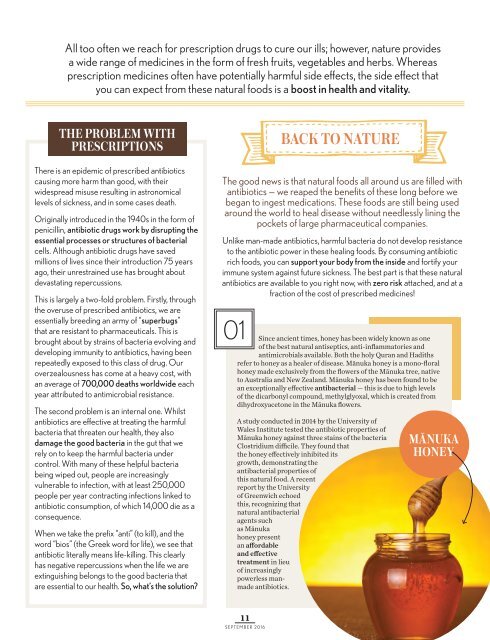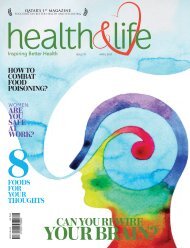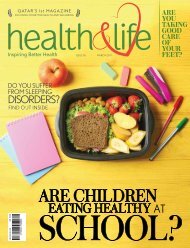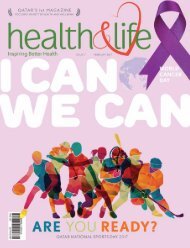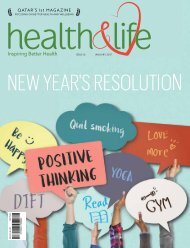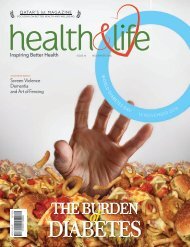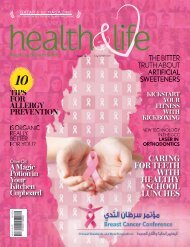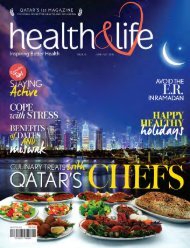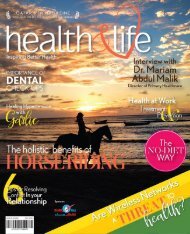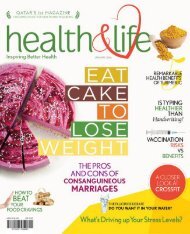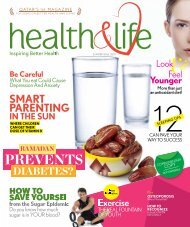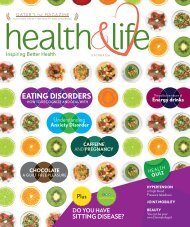Health and life magazine September 2016
Health and life magazine september 2016
Health and life magazine september 2016
- No tags were found...
You also want an ePaper? Increase the reach of your titles
YUMPU automatically turns print PDFs into web optimized ePapers that Google loves.
All too often we reach for prescription drugs to cure our ills; however, nature provides<br />
a wide range of medicines in the form of fresh fruits, vegetables <strong>and</strong> herbs. Whereas<br />
prescription medicines often have potentially harmful side effects, the side effect that<br />
you can expect from these natural foods is a boost in health <strong>and</strong> vitality.<br />
THE PROBLEM WITH<br />
PRESCRIPTIONS<br />
There is an epidemic of prescribed antibiotics<br />
causing more harm than good, with their<br />
widespread misuse resulting in astronomical<br />
levels of sickness, <strong>and</strong> in some cases death.<br />
Originally introduced in the 1940s in the form of<br />
penicillin, antibiotic drugs work by disrupting the<br />
essential processes or structures of bacterial<br />
cells. Although antibiotic drugs have saved<br />
millions of lives since their introduction 75 years<br />
ago, their unrestrained use has brought about<br />
devastating repercussions.<br />
This is largely a two-fold problem. Firstly, through<br />
the overuse of prescribed antibiotics, we are<br />
essentially breeding an army of “superbugs”<br />
that are resistant to pharmaceuticals. This is<br />
brought about by strains of bacteria evolving <strong>and</strong><br />
developing immunity to antibiotics, having been<br />
repeatedly exposed to this class of drug. Our<br />
overzealousness has come at a heavy cost, with<br />
an average of 700,000 deaths worldwide each<br />
year attributed to antimicrobial resistance.<br />
The second problem is an internal one. Whilst<br />
antibiotics are effective at treating the harmful<br />
bacteria that threaten our health, they also<br />
damage the good bacteria in the gut that we<br />
rely on to keep the harmful bacteria under<br />
control. With many of these helpful bacteria<br />
being wiped out, people are increasingly<br />
vulnerable to infection, with at least 250,000<br />
people per year contracting infections linked to<br />
antibiotic consumption, of which 14,000 die as a<br />
consequence.<br />
When we take the prefix “anti” (to kill), <strong>and</strong> the<br />
word “bios” (the Greek word for <strong>life</strong>), we see that<br />
antibiotic literally means <strong>life</strong>-killing. This clearly<br />
has negative repercussions when the <strong>life</strong> we are<br />
extinguishing belongs to the good bacteria that<br />
are essential to our health. So, what’s the solution?<br />
The good news is that natural foods all around us are filled with<br />
antibiotics — we reaped the benefits of these long before we<br />
began to ingest medications. These foods are still being used<br />
around the world to heal disease without needlessly lining the<br />
pockets of large pharmaceutical companies.<br />
Unlike man-made antibiotics, harmful bacteria do not develop resistance<br />
to the antibiotic power in these healing foods. By consuming antibiotic<br />
rich foods, you can support your body from the inside <strong>and</strong> fortify your<br />
immune system against future sickness. The best part is that these natural<br />
antibiotics are available to you right now, with zero risk attached, <strong>and</strong> at a<br />
fraction of the cost of prescribed medicines!<br />
01<br />
BACK TO NATURE<br />
Since ancient times, honey has been widely known as one<br />
of the best natural antiseptics, anti-inflammatories <strong>and</strong><br />
antimicrobials available. Both the holy Quran <strong>and</strong> Hadiths<br />
refer to honey as a healer of disease. Mānuka honey is a mono-floral<br />
honey made exclusively from the flowers of the Mānuka tree, native<br />
to Australia <strong>and</strong> New Zeal<strong>and</strong>. Mānuka honey has been found to be<br />
an exceptionally effective antibacterial — this is due to high levels<br />
of the dicarbonyl compound, methylglyoxal, which is created from<br />
dihydroxyacetone in the Mānuka flowers.<br />
A study conducted in 2014 by the University of<br />
Wales Institute tested the antibiotic properties of<br />
Mānuka honey against three stains of the bacteria<br />
Clostridium difficile. They found that<br />
the honey effectively inhibited its<br />
growth, demonstrating the<br />
antibacterial properties of<br />
this natural food. A recent<br />
report by the University<br />
of Greenwich echoed<br />
this, recognizing that<br />
natural antibacterial<br />
agents such<br />
as Mānuka<br />
honey present<br />
an affordable<br />
<strong>and</strong> effective<br />
treatment in lieu<br />
of increasingly<br />
powerless manmade<br />
antibiotics.<br />
MĀNUKA<br />
HONEY<br />
11<br />
SEPTEMBER <strong>2016</strong>


